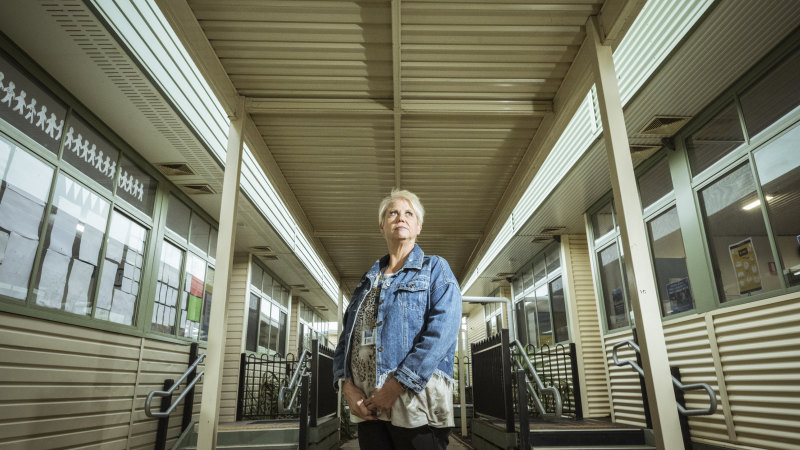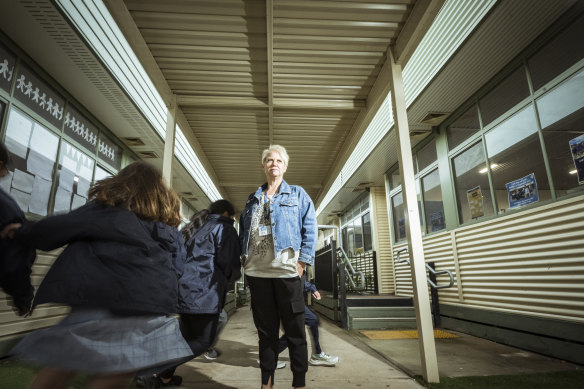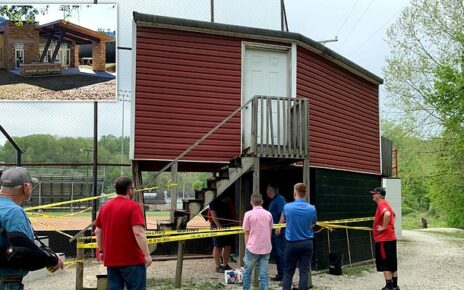Save articles for later
Add articles to your saved list and come back to them any time.
Anne-Maree Kliman calls her school “portable city”.
The principal’s Tarneit P-9 College in Melbourne’s west is bursting with 36 relocatable buildings that house 64 classrooms and other facilities – and that make up two-thirds of the school.
Tarneit P-9 College principal Anne-Maree Kliman.Credit: Chris Hopkins
School building authorities claim portables are a cost-effective way of dealing with fluctuating student enrolments, but principals worry they eat into open play space and that existing schools are being overlooked for upgrades in favour of new builds.
Tarneit has the third-highest number of portables in the state. The school with the most is Alamanda K-9 College, 30 minutes down the road, which has 61 relocatable buildings containing space for 122 classrooms. Hazel Glen College in Melbourne’s north-east has 49.
Figures obtained by The Age under freedom of information show that there were 5761 relocatable classroom buildings placed at 1130 state schools as of August this year. Of those, 35 schools had 20 or more demountables and 137 had more than 10.
Of the 13 new schools that opened this year, five are already on the list; four with four relocatable classroom buildings and one that has a single portable.
Relocatable buildings – or demountables as they were previously known – normally house two classrooms, with a small, multipurpose room or office in between. Double storey buildings with four classrooms are also common. Triple story buildings are available but rare.
The Victorian School Building Authority says relocatable buildings are a “cost-effective, flexible and rapid means of supplementing existing classrooms in schools with fluctuating enrolments”.
But for many schools, these classrooms have become a permanent fixture.
Tarneit had 21 relocatables within two years of opening in 2013. It added another permanent building in 2018 but has since acquired another 15 portables. Next year, it will add three more.
Kliman said the new relocatables would increase specialist space for science and food technology classes, but that sport lessons were still a problem with one gymnasium to service 2266 students. Some of the current demountables are also decades old and contain asbestos.
The college is now running out of available space to support more demountables, which are eating into playgrounds.
“I understand the purpose of the relocatable program, but I am not sure it is intended to make up 70 per cent of a school,” Kliman said.
Tarneit P-9 College is located in Wyndham, one of the fastest-growing local government areas in Australia. Three new primary schools opened in the area this year. Another two secondary schools and four primary schools will open in 2024.
The college already runs a split timetable just to accommodate the movement of its thousands of students.
Kliman is concerned that the Education Department is overlooking existing schools in an attempt to meet ongoing population pressure with new builds.
“They should be looking at [schools] when they’re rapidly growing and … recognising that there’s a need for those permanent buildings at that point in time, not waiting until it gets to a point where we’re overflowing with relocatables,” Kliman said. “It should be a constant review.”
Ben Cleveland, an associate professor in learning environments at the University of Melbourne, has been researching school design for more than a decade and has helped design more than 50 schools in Victoria.
He said government policy dictated that 20 per cent of students should be housed in relocatables, so a school wasn’t left with more permanent buildings than it needed when enrolments declined.
Cleveland said it was reasonable for schools to have some relocatables but that more than 30 was a “very large number”.
“They’re probably schools that need to have their infrastructure reviewed for what’s actually going to be needed for the 20 years,” he said.
Cleveland said newer relocatables were as comfortable as permanent buildings but could still be challenging as flexible learning spaces. Portables more than 10 years old, however, were “not great learning environments”, he said, and that schools ran into problems when demountables consumed recreational areas.
Australian Education Union Victorian branch president Meredith Peace said the government had upgraded and built many schools since 2014, but it was essential that investment continued.
“Schools should not have to over-rely on contingency measures such as demountables to accommodate the student population,” she said.
An Education Department spokesperson said the Victorian government had spent $14.9 billion on new schools and upgrades in the past nine years, and that relocatable buildings were a cost-effective way to support schools with growing enrolments.
“Permanent school buildings, which are modern, comfortable and fit-for-purpose, are built to meet predicted long-term enrolments and we review every year as part of the annual budget process.”
But opposition education spokeswoman Jess Wilson said the proliferation of portable classrooms across Victoria demonstrated a failure to plan and the building authority should immediately audit all schools with relocatables.
“Portable classrooms should be used for short-term needs, but with some being in place for more than a decade, its clear schools across Victoria are being let down by this government,” she said.
Kliman, the principal in Tarneit, said she was grateful for the new relocatables but frustrated by the lack of a planning for future buildings while her students continued to learn in some relocatables no longer fit for purpose.
“They’re built 40, 50 years ago and they’re on a site that’s only 10 years old.”
Get the day’s breaking news, entertainment ideas and a long read to enjoy. Sign up to receive our Evening Edition newsletter.
Most Viewed in National
From our partners
Source: Read Full Article




